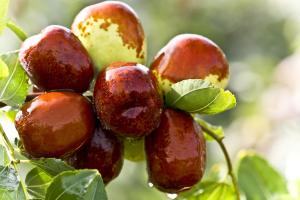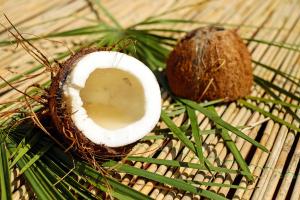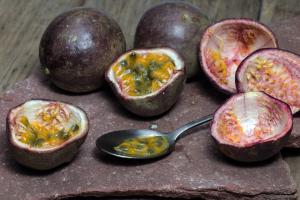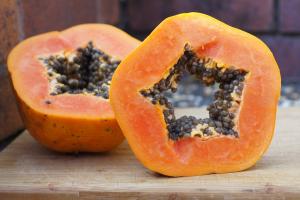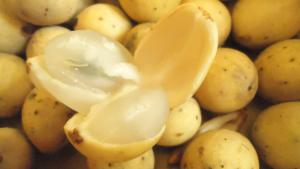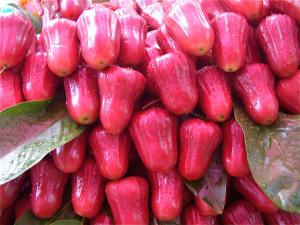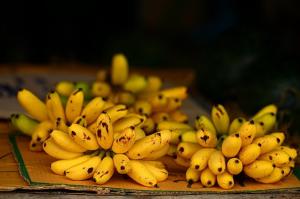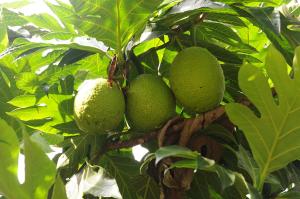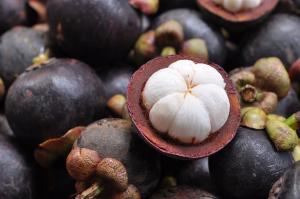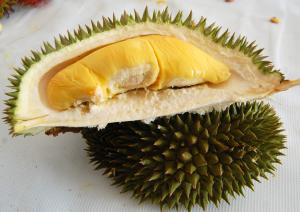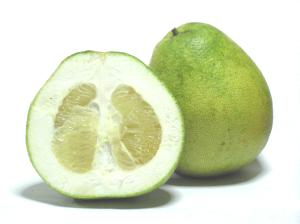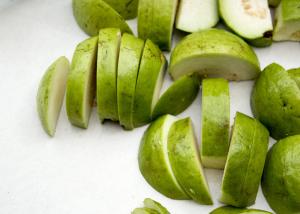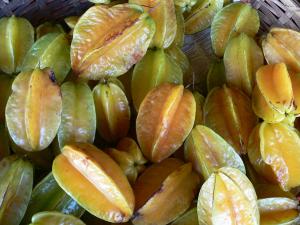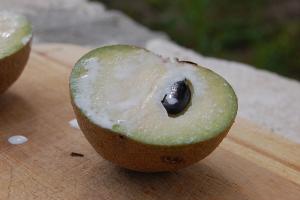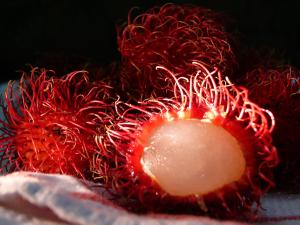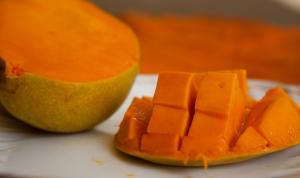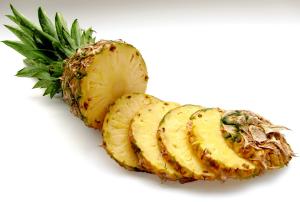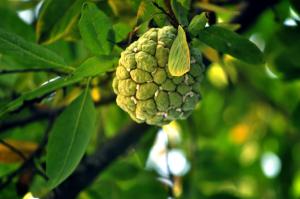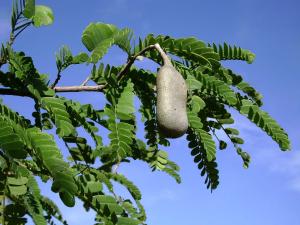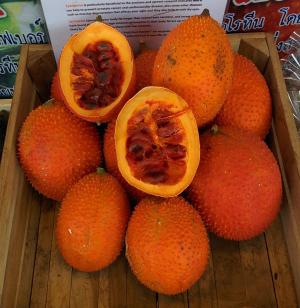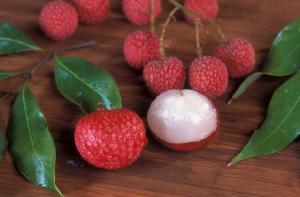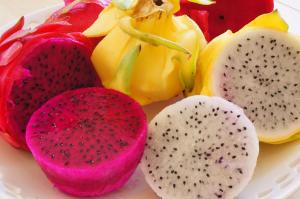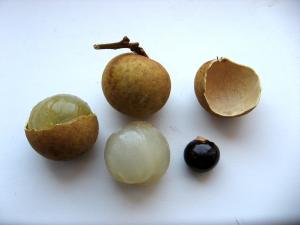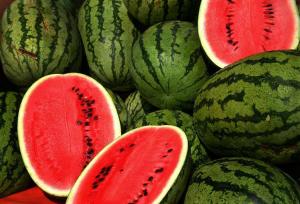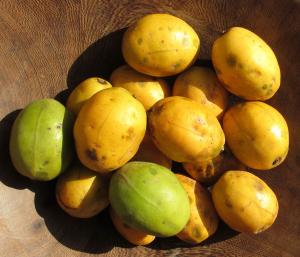Thai Fruits
It is a small deciduous tree or shrub reaching a height of 5–12 metres (16–39 ft), usually with thorny branches. The leaves are shiny-green, ovate-acute, 2–7 centimetres (0.79–2.76 in) long and 1–3 centimetres (0.39–1.18 in) wide, with three conspicuous veins at the base, and a finely toothed... more
Coconuts are known for their great versatility, as evidenced by many traditional uses, ranging from food to cosmetics. They form a regular part of the diets of many people in the tropics and subtropics. Coconuts are distinct from other fruits for their large quantity of water (also called "juice... more
Passiflora edulis is a vine species of passion flower that is native to southern Brazil through Paraguay to northern Argentina. Its common names include passion fruit or passionfruit (English), maracuya (Spanish), grenadille (French), maracujá (Portuguese) and lilikoʻi (Hawaiian). It is... more
The papaya is a small, sparsely branched tree, usually with a single stem growing from 5 to 10 m (16 to 33 ft) tall, with spirally arranged leaves confined to the top of the trunk. The lower trunk is conspicuously scarred where leaves and fruit were borne. The leaves are large, 50–70 cm (20–28... more
The fruit can be elliptical, ovoid or round, measuring 2 to 7 centimetres (0.79 to 2.76 in) by 1.5 to 5 centimetres (0.59 to 1.97 in) in size. Fruits look much like small potatoes and are borne in clusters similar to grapes. The larger fruits are on the variety known as duku. It is covered by... more
When ripe, the fruit will puff outwards, with a slight concavity in the middle of the underside of the "bell". Healthy wax apples have a light sheen to them. Despite its name, a ripe wax apple only resembles an apple on the outside in color. It does not taste like an apple, and it has neither... more
Lady Finger bananas are eaten fresh or used in desserts. They are known for being sweeter than the common Cavendish-type bananas.
Breadfruit can be eaten once cooked, or can be further processed into a variety of other foods. A common product is a mixture of cooked or fermented breadfruit mash mixed with coconut milk and baked in banana leaves. Whole fruits can be cooked in an open fire, then cored and filled with other... more
The purple mangosteen (Garcinia mangostana), colloquially known simply as mangosteen, is a tropical evergreen tree believed to have originated in the Sunda Islands and the Moluccas of Indonesia. It grows mainly in Southeast Asia, southwest India and other tropical areas such as Puerto Rico and... more
Regarded by many people in southeast Asia as the "king of fruits", the durian is distinctive for its large size, strong odour, and formidable thorn-covered husk. The fruit can grow as large as 30 centimetres (12 in) long and 15 centimetres (6 in) in diameter, and it typically weighs one to three... more
A natural (non-hybrid) citrus fruit, similar in appearance to a large grapefruit, native to South and Southeast Asia.
Guava fruits, usually 4 to 12 centimetres (1.6 to 4.7 in) long, are round or oval depending on the species. They have a pronounced and typical fragrance, similar to lemon rind but less sharp. The outer skin may be rough, often with a bitter taste, or soft and sweet. Varying between species, the... more
The fruit has distinctive ridges running down its sides (usually five but can sometimes vary); when cut in cross-section, it resembles a star, hence its name. The entire fruit is edible and is usually eaten out of hand. They may also be used in cooking and can be made into relishes, preserves,... more
The fruit is a large berry, 4–8 cm (1.6–3.1 in) in diameter. Inside, its flesh ranges from a pale yellow to an earthy brown color with a grainy texture akin to that of a well-ripened pear. Each fruit contains one to six seeds. The seeds are hard, glossy, and black, resembling beans, with a hook... more
The rambutan (/ræmˈbuːtən/; taxonomic name: Nephelium lappaceum) is a medium-sized tropical tree in the family Sapindaceae. The name also refers to the edible fruit produced by this tree. The rambutan is native to the Malay-Indonesian region, and other regions of tropical Southeast Asia. It is... more
Mangoes are juicy stone fruit (drupe) belonging to the genus Mangifera, consisting of numerous tropical fruiting trees, cultivated mostly for edible fruit. The majority of these species are found in nature as wild mangoes. They all belong to the flowering plant family Anacardiaceae. The mango is... more
It is native to parts of South and Southeast Asia and is believed to have originated in the southwestern rain forests of the Western Ghats in the Indian subcontinent. The jackfruit tree is well suited to tropical lowlands, and its fruit is the largest tree-borne fruit, reaching as much as 35 kg... more
The pineapple (Ananas comosus) is a tropical plant with an edible multiple fruit consisting of coalesced berries, also called pineapples, and the most economically significant plant in the Bromeliaceae family. Pineapples may be cultivated from a crown cutting of the fruit, possibly flowering in... more
The fruit is spherical through conical, 5–10 cm (2.0–3.9 in) in diameter and 6–10 cm (2.4–3.9 in) long, and weighing 100–240 g (3.5–8.5 oz), with a thick rind composed of knobby segments. The color is typically pale green through blue-green, with a deep pink blush in certain varieties, and... more
The pulp is used to give a pleasant sour taste to some soups, curries and Pad Thai. Also used to make sweets and refreshing drinks.
Because it has a relatively short harvest season (which peaks in December and January), making it less abundant than other foods, gac is typically served at ceremonial or festive occasions in Vietnam, such as Tết (the Vietnamese new year) and weddings. It is most commonly prepared as a dish... more
The lychee, litchi, liechee, liche, lizhi or li zhi, or lichee (Litchi chinensis; Chinese: 荔枝) is the sole member of the genus Litchi in the soapberry family, Sapindaceae. It is a tropical fruit tree native to the Guangdong and Fujian provinces of China, where cultivation is documented 1059 AD.... more
A pitaya /pᵻˈtaɪ.ə/ or pitahaya /ˌpɪtəˈhaɪ.ə/ is the fruit of several cactus species indigenous to the Americas. "Pitaya" usually refers to fruit of the genus Stenocereus, while "pitahaya" or "dragon fruit" refers to fruit of the genus Hylocereus.
The longan (simplified Chinese: 龙眼; traditional Chinese: 龍眼; pinyin: lóngyǎn; Pe̍h-ōe-jī: Lêng-géng; literally: "dragon eye"), is so named because it resembles an eyeball when its fruit is shelled (the black seed shows through the translucent flesh like a pupil/iris). The seed is small, round... more
Watermelon rinds are also edible, but most people avoid eating them due to their unappealing flavor. They are used for making pickles, sometimes eaten in the Southern US, and less often as a vegetable, where the rind is stir-fried or stewed. The amino acid citrulline is produced in watermelon... more
The fruit may be eaten raw; the flesh is crunchy and a little sour. According to Boning (2006): "The fruit is best when fully colored, but still somewhat crunchy. At this stage, it has a pineapple-mango flavor. The flesh is golden in color, very juicy, vaguely sweet, but with a hint of tart... more
